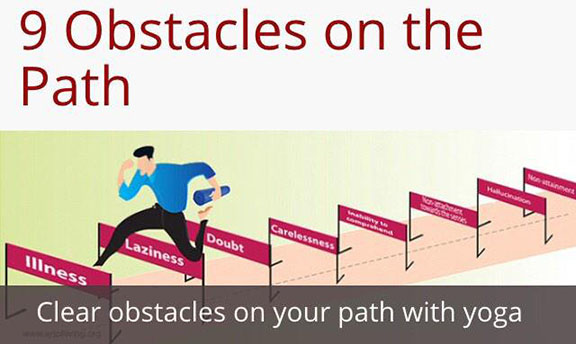 Rev. Jaganath, Integral Yoga Minister and Raja Yoga master teacher, has spent a lifetime delving into the deepest layers of meaning in Patanjali’s words within the Yoga Sutras. Our series continues with the 31st and 32nd sutras of Chapter 1 in which Patanjali further delineates the nine main impediments by expounding on the “accompaniments” to the obstacles to spiritual practice and spiritual growth. But, Patanjali not only describes the obstacles and how to recognize them, he offers a guidance on how to prevent these impediments.
Rev. Jaganath, Integral Yoga Minister and Raja Yoga master teacher, has spent a lifetime delving into the deepest layers of meaning in Patanjali’s words within the Yoga Sutras. Our series continues with the 31st and 32nd sutras of Chapter 1 in which Patanjali further delineates the nine main impediments by expounding on the “accompaniments” to the obstacles to spiritual practice and spiritual growth. But, Patanjali not only describes the obstacles and how to recognize them, he offers a guidance on how to prevent these impediments.
Sutra 1.31: duḥkha-daurmanasya-angam-ejayatva-śvāsa-praśvāsāḥ vikṣepa-sahabhuvaḥ
These distracting obstacles are accompanied by:
- duḥkha: dissatisfaction, sorrow, suffering, and a pervasive, persistent feeling of precariousness
- Frustration from not having desires fulfilled
- Restlessness or trembling of the body
- Agitated or labored inhalation or exhalation
When the mind wanders in its focus or resolve, the obstacles appear accompanied by any or all of these accompaniments.
duḥkha = pervasive, persistent uneasiness or dissatisfaction; discontent, distress, anxiety, stress, pain, uneasiness, difficulty, sorrow, trouble, to cause or feel pain, unpleasant (See 1.31, 1.33, 2.5, 2.15, 2.16, 2.34)
from duṣ = difficult, wicked, bad, inferior + kha = axle hole, cavity, hollow, cave
The essence of duhkha, often translated as pain, sorrow, or suffering is more than that. It is grounded in a persistent sense of never-ending precariousness, a baseline of uneasiness or anxiety that forms the backdrop of our lives. Duhkha is a feeling or belief that life is flawed; that it can’t be trusted. Duhkha, manifesting as suspicion is the pathology of ignorance.
Duhkha in its most insidious form is a background of quietly screeching violins seeming to warn us of possible pain behind the closed door we are about to open (or decisions or plans, or relationships).
Duhkha is born of fear, uncertainty, ignorance of our True Nature, and attachments to our dreams or personal visions of our future.
The opposite of duhkha can be said to be sukha, pleasure or happiness. But, it might be more accurate, or at least, more helpful, to think of trust as the opposite of duhkha. We see in sutra 2.28, that the entire universe exists to give us experiences and liberation. It would not be incorrect to understand this as an act of love. Out of love, the universe manifests and acts. When we learn to trust that we are loved, that the universe is a benevolent place, then and only then, are we truly free to accept and to give love. This trust in life also eradicates greed, lust, fear, anger, and resentment.
How do we develop this trust? Through cultivating gratitude, by daily remembering all the gifts we have been freely given: our mind, our friends, the sun, the scent of a rose, the thirst for knowledge, laughter, song, a tasty peach, the great sages and saints of all faith traditions. Gratitude ripens into devotion; devotion into trust—faith.
daurmanasya = frustration; despair, depression, dejectedness, melancholy, sorrow from having a desire frustrated, a deep, pensive and long-lasting sadness, it is a form of mental agitation
from daur = a strengthened form of duṣ = difficult, inferior, bad + manasya = have in mind, think, from man = to think, conjecture
angam = body; limb
ejayatva = trembling, restlessness; unsteady, shaking
from ej = stir, move, tremble
Agitated or labored breathing is implied from ejayatva.
śvāsa = inhalation
from śvas = to pant, to breathe, draw breath, to sigh, groan, to cause heavy breathing
praśvāsāḥ = exhalation
from pra = before, forward + śvāsa = inhalation, breath
vikṣepa = distracting obstacles; dispersion of intents and resolves of the mind, the act of throwing asunder or away or about, scattering, dispersion, discharging, moving to and fro, waving, shaking, tossing, letting loose, indulging (the opposite of samyama), letting slip, neglecting, inattention, distraction, confusion, perplexity, a kind of disease
from vi = away, asunder + kṣepa = throwing, casting, from kṣip = throw, send
sahabhuvaḥ = accompany; appearing together, counterpart of
from saha = together with + bhuva = from bhū = to be or exist
Sutra 1.32: tat-pratiṣedha-artham eka-tattva-abhyasa
The practice of concentration on a single subject [the use of one technique] is the best way to prevent the obstacles and their accompaniments (Swami Satchidananda translation). In order to prevent the distracting obstacles and their accompaniments, commit to the teachings and practices of one path (Rev. Jaganath translation).
This sutra adds another facet or option to the methods for overcoming the distracting obstacles presented in sutras 1.30 and 1.31.
Here we are given the importance of regularity and of maintaining our efforts within an established, proven tradition. For example, sporadic repetition of a mantra outside the supportive practices and lifestyle of an established yogic path usually does not produce the desired or optimal results. Even a regular practice can greatly benefit from the cohesiveness and time-and-effort-saving teachings within a yogic tradition, a lineage or school of thought, with its built-in checks and balances.
Changing approaches and techniques whenever the mind feels bored or disappointed can aggravate the obstacles (1.30), all of which are based on restlessness of mind.
tat = (refers to the distracting obstacles and their accompaniments); these, them
pratiṣedha = prevent; counteract, keeping back, warding off, prevention, repulsion (of a disease), refusal, denial, contradiction, exception, negation
from prati = against, back + sedha = driving away from, from sidh = repel
artham = in order to; purpose, meaning, aim, purpose, cause, motive, reason, advantage, use, utility, relating to a thing or object, material, resulting from or based on the possession of a thing.
eka = one; single
When we talk about sticking to one path, we are talking about the focus, harmony, holism that is found in any proven school of thought and practices. Even though in the beginning, it is usually best to experiment with different spiritual paths, it is recommended to stick to the path or tradition that resonates most deeply for us. It is better to dig deeply in one place to find water than to continually dig shallow wells.
Though the superficial characteristics of every genuine path may differ, in essence, they are the same. Every faith tradition is about evaluating what’s important in life, seeking what brings peace and harmony and what brings pain; it’s about turning from selfish cravings and toward selfless service; it’s about transcending spiritual ignorance.
As seekers approach Me, so do I receive them. All paths, Arjuna, lead to Me. —Bhagavad Gita 4.11
And Peter opened his mouth and said, “Truly I perceive that God shows no partiality, but in every nation anyone who fears him and does what is right is acceptable to Him. —Bible, Acts 10.34-35
Confucius said… “In the world there are many different roads but the destination is the same. There are a hundred deliberations but the result is one.” —I Ching, Appended Remarks 2.5
At any time, in any form and accepted name, if one is shorn of all attachment, that one is you alone. My Lord! You are one although variously appearing. —Hemachandra, Dvatrimshika (Jainism)
tattva = teachings; subject, true or real state, truth, reality, principle, the essence or substance of anything, an elementary property of existence, thatness, a category of cosmic existence (the elements and essences of prakriti, for example)
from tat = that + tva = the quality of something; literally, that-ness
Tattva refers to the principles that make up a school of theories and practices. The Yoga Sutras are the tattvas (the principle teachings) of Patanjali.
abhyasa = practices (See 1.12)
About the Author:
 Reverend Jaganath Carrera is and Integral Yoga Minister and the founder/spiritual head of Yoga Life Society. He is a direct disciple of world renowned Yoga master and leader in the interfaith movement, Sri Swami Satchidananda—the founder and spiritual guide of Satchidananda Ashram–Yogaville and Integral Yoga International. Rev. Jaganath has taught at universities, prisons, Yoga centers, and interfaith programs both in the USA and abroad. He was a principal instructor of both Hatha and Raja Yoga for the Integral Yoga Teacher Training Certification Programs for over twenty years and co-wrote the training manual used for that course. He established the Integral Yoga Ministry and developed the highly regarded Integral Yoga Meditation and Raja Yoga Teacher Training Certification programs. He served for eight years as chief administrator of Satchidananda Ashram–Yogaville and founded the Integral Yoga Institute of New Brunswick, NJ. He is also a spiritual advisor and visiting lecturer on Hinduism for the One Spirit Seminary in New York City. Reverend Jaganath is the author of Inside the Yoga Sutras: A Sourcebook for the Study and Practice of Patanjali’s Yoga Sutras, published by Integral Yoga Publications. His latest book, Patanjali’s Words, is coming soon from Integral Yoga Publications.
Reverend Jaganath Carrera is and Integral Yoga Minister and the founder/spiritual head of Yoga Life Society. He is a direct disciple of world renowned Yoga master and leader in the interfaith movement, Sri Swami Satchidananda—the founder and spiritual guide of Satchidananda Ashram–Yogaville and Integral Yoga International. Rev. Jaganath has taught at universities, prisons, Yoga centers, and interfaith programs both in the USA and abroad. He was a principal instructor of both Hatha and Raja Yoga for the Integral Yoga Teacher Training Certification Programs for over twenty years and co-wrote the training manual used for that course. He established the Integral Yoga Ministry and developed the highly regarded Integral Yoga Meditation and Raja Yoga Teacher Training Certification programs. He served for eight years as chief administrator of Satchidananda Ashram–Yogaville and founded the Integral Yoga Institute of New Brunswick, NJ. He is also a spiritual advisor and visiting lecturer on Hinduism for the One Spirit Seminary in New York City. Reverend Jaganath is the author of Inside the Yoga Sutras: A Sourcebook for the Study and Practice of Patanjali’s Yoga Sutras, published by Integral Yoga Publications. His latest book, Patanjali’s Words, is coming soon from Integral Yoga Publications.

